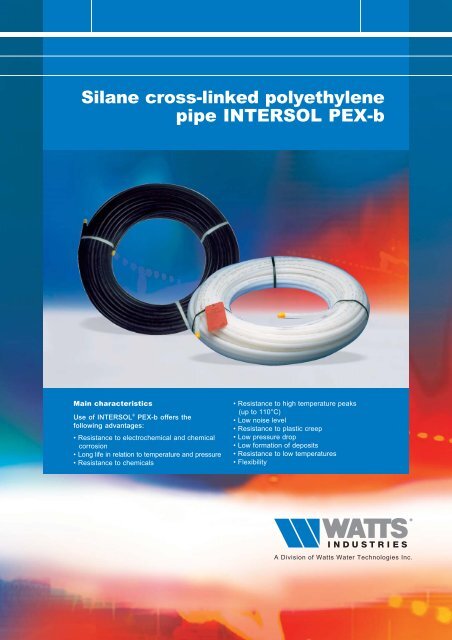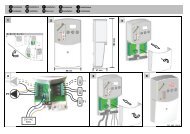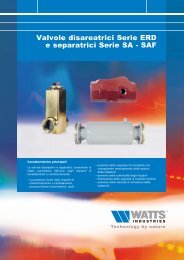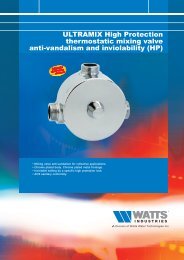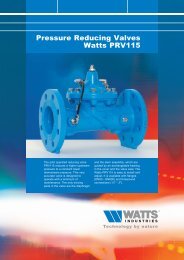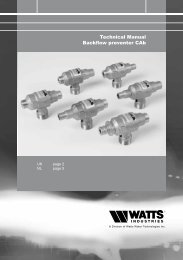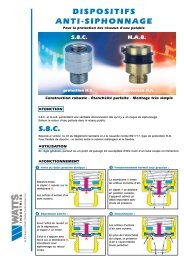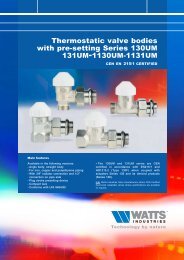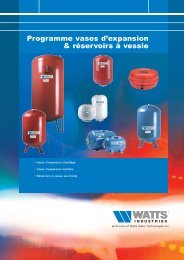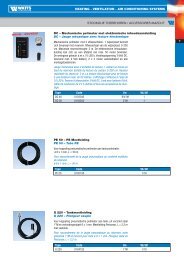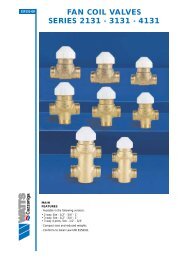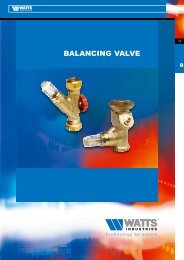Silane cross-linked polyethylene pipe INTERSOL ... - Watts Industries
Silane cross-linked polyethylene pipe INTERSOL ... - Watts Industries
Silane cross-linked polyethylene pipe INTERSOL ... - Watts Industries
You also want an ePaper? Increase the reach of your titles
YUMPU automatically turns print PDFs into web optimized ePapers that Google loves.
<strong>Silane</strong> <strong>cross</strong>-<strong>linked</strong> <strong>polyethylene</strong><br />
<strong>pipe</strong> <strong>INTERSOL</strong> PEX-b<br />
Main characteristics<br />
Use of <strong>INTERSOL</strong> ®<br />
PEX-b offers the<br />
following advantages:<br />
• Resistance to electrochemical and chemical<br />
corrosion<br />
• Long life in relation to temperature and pressure<br />
• Resistance to chemicals<br />
• Resistance to high temperature peaks<br />
(up to 110°C)<br />
• Low noise level<br />
• Resistance to plastic creep<br />
• Low pressure drop<br />
• Low formation of deposits<br />
• Resistance to low temperatures<br />
• Flexibility<br />
A Division of <strong>Watts</strong> Water Technologies Inc.
SILANE CROSS-LINKED POLYETHYLENE PIPE<br />
2<br />
Piping of the <strong>INTERSOL</strong> ® PEX-b series is made from <strong>cross</strong>-<strong>linked</strong> <strong>polyethylene</strong>, available in versions with or<br />
without oxygen diffusion barrier, and suitable for <strong>pipe</strong>s used for supplying the heat carrier fluid in<br />
heating/plumbing systems.<br />
TPR<br />
<strong>INTERSOL</strong> ®<br />
Cross-<strong>linked</strong> <strong>polyethylene</strong> <strong>pipe</strong>. Can be used as a viable alternative to<br />
conventional piping (copper - steel - iron). Suitable for heating and plumbing<br />
systems as it is non toxic.<br />
Easy to install. Low pressure drops. Age and corrosion resistant.<br />
Max. temperature: 100 °C.<br />
Conforms with UNI 9338. Approved according to UNI 315 IIP no. 206.<br />
Type Part number Dimensions<br />
TPR 1001112 12 x 2,0<br />
TPR 1001115 15 x 2,5<br />
TPR 1001118 18 x 2,5<br />
TPR 1001120 20 x 2,0<br />
TPR 1001122 22 x 3,0<br />
TPR 1001128 28 x 3,0<br />
TPR 1001132 32 x 3,0<br />
TPRUV<br />
<strong>INTERSOL</strong> ®<br />
Cross-<strong>linked</strong> <strong>polyethylene</strong> <strong>pipe</strong> resistant to the aging action of UV rays.<br />
Characteristics like TPR, but suitable above all for outdoor sections exposed to<br />
sunlight.<br />
Conforms with UNI 9338. Approved according to UNI 315 IIP no. 206.<br />
Type Part number Dimensions<br />
TPRUV 1001512 12 x 2,0<br />
TPRUV 1001515 15 x 2,5<br />
TPRUV 1001518 18 x 2,5<br />
TPRUV 1001522 22 x 3,0<br />
TPRUV 1001528 28 x 3,0<br />
TPRUV 1001532 32 x 3,0<br />
VPESR<br />
<strong>INTERSOL</strong> ®<br />
Cross-<strong>linked</strong> polythene <strong>pipe</strong> enclosed in corrugated <strong>polyethylene</strong> sheath.<br />
Characteristics like TPR.<br />
Black sheath.<br />
Conforms with UNI 9338. Approved according to UNI 315 IIP no. 206.<br />
(does not include the sheath).<br />
Type Part number Dimensions<br />
VPESR 1001905 15 x 2,5<br />
VPESR 1001909 18 x 2,5
SILANE CROSS-LINKED POLYETHYLENE PIPE<br />
VPEED<br />
<strong>INTERSOL</strong> ®<br />
Cross-<strong>linked</strong> polythene <strong>pipe</strong> with oxygen diffusion barrier to prevent oxygen<br />
in the air from penetrating inside the water circuit.<br />
Suitable for building radiant panel systems.<br />
Other characteristics like TPR.<br />
3<br />
Conforms with DIN 16892/16898.<br />
Approved according to DIN 4726/4729.<br />
Type Part number Dimensions<br />
VPEED 1001165 16 x 2,0<br />
VPEED 1001166 16 x 2,0<br />
VPEED 1001175 17 x 2,0<br />
VPEED 1001176 17 x 2,0<br />
VPEED 1001185 18 x 2,0<br />
VPEED 1001186 18 x 2,0<br />
VPEED 1001205 20 x 2,0<br />
VPEED 1001206 20 x 2,0<br />
TPRR<br />
<strong>INTERSOL</strong> ®<br />
Like VPEDD but without the oxygen diffusion barrier.<br />
Conforms with DIN 16892/16893 - UNI 9338.<br />
Type Part number Dimensions<br />
TPRR 1001160 16 x 2,0<br />
TPRR 1001161 16 x 2,0<br />
TPRR 1001170 17 x 2,0<br />
TPRR 1001171 17 x 2,0<br />
TPRR 1001180 18 x 2,0<br />
TPRR 1001181 18 x 2,0<br />
TPRR 1001200 20 x 2,0<br />
TPRR 1001201 20 x 2,0<br />
1 - PLASTICS USED IN HOT /COLD WATER PRESSURE PIPING<br />
<strong>INTERSOL</strong> ® PEX-b is a <strong>cross</strong>-<strong>linked</strong> <strong>polyethylene</strong> <strong>pipe</strong> obtained via the silane method, starting from high density<br />
<strong>polyethylene</strong>. It finds application in the heating and plumbing sector.<br />
In this sector (floor heating, radiator <strong>pipe</strong> connecting, plumbing systems) it is possible to use the following plastic<br />
materials instead of conventional metal ones:<br />
- Polyethylene (PE)<br />
- Chlorinated polyvinyl chloride (PVC-C)<br />
- Cross-<strong>linked</strong> <strong>polyethylene</strong> (PEX)<br />
- Polypropylene random copolymer (PP-R)<br />
- Polybutylene (PB)<br />
Table 1 shows the fields of application of plastics in the pressure <strong>pipe</strong> sectors.<br />
Table 1<br />
Application PE PVC-C PEX PP-R PB<br />
Domestic cold water Yes Yes Yes Yes Yes<br />
Domestic hot water (60°C) No Yes Yes Yes Yes<br />
Floor heating No No Yes (Yes) Yes<br />
Radiator <strong>pipe</strong> connecting No No Yes No (Yes)<br />
Legend<br />
Yes = used<br />
(Yes) = used less frequently<br />
No = not used
SILANE CROSS-LINKED POLYETHYLENE PIPE<br />
2 - CROSS-LINKING METHOD<br />
4<br />
High density <strong>polyethylene</strong> is a thermoplastic macromolecular component, obtained from the polymerization of the<br />
ethylene monomer (CH2 = CH2).<br />
Its chemical formula can be represented as: - (CH2 - CH2) - n<br />
where n defines the length of the macromolecular chain (the average value of n can also lie between<br />
10,000 – 16,000). From now onwards we shall represent such chain as:<br />
Hence <strong>polyethylene</strong> consists of various macromolecular (polymer) chains, whose cohesion forces cannot strictly<br />
be considered to be true chemical bonds, rather they are electrical in nature and are commonly known as “Van<br />
der Waals” forces. Although such cohesion forces are low, the high number of intramolecular bonds favours<br />
obtaining of certain properties for the product.<br />
However the low energy of the cohesion forces makes the thermoplastic materials highly sensitive to temperature,<br />
which causes considerable decay of the properties.<br />
Suppose in addition to the “Van der Waals” forces, we introduce intramolecular chemical bonds (the so-called<br />
<strong>cross</strong>-linking bonds), the thermal properties of the product will be considerably improved.<br />
Cross-linking is a process which modifies the chemical structure of the material, by creating a three dimensional<br />
“network” structure thanks to links between the polymer chains. The new structure determines certain special<br />
characteristics, namely:<br />
• an increase in the maximum operating temperature<br />
• a reduction in creep deformation (creep)<br />
• improved chemical resistance<br />
• improved resistance to UV rays<br />
• improved abrasion resistance<br />
• greater impact strength<br />
• less notch sensitivity and abrasion<br />
• thermal memory characteristics are conferred to the material (“thermoelastic polymer”)<br />
2.1 - Classification of the <strong>cross</strong>-<strong>linked</strong> <strong>polyethylene</strong><br />
Cross-<strong>linked</strong> <strong>polyethylene</strong> is classified according to the methods used to perform the <strong>cross</strong>-linking as summed up<br />
in the following table:<br />
Table 2<br />
Type of <strong>cross</strong>-linking Cross-linking agent Product symbol<br />
a Chemical Peroxides PEX-a<br />
b Chemical <strong>Silane</strong>s PEX-b<br />
c Physical Electronic rays (beta) PEX-c<br />
d Chemical Azo compounds PEX-d<br />
Processes a, b and c are the most frequent ones and they will be described in the following pages.<br />
2.2 - Chemical <strong>cross</strong>-linking with peroxides (PEX-a)<br />
In the Engel method, the peroxide (chemical formula ROOR) is added to <strong>polyethylene</strong> during the extrusion phase.<br />
The process consists of two steps, namely:<br />
• formation of free radicals<br />
• <strong>cross</strong>-linking<br />
+ ROOR + ROH<br />
+<br />
Special machines that allow reaching of pressures up to 2000 bar are required to complete such process.
SILANE CROSS-LINKED POLYETHYLENE PIPE<br />
2.3 - Physical <strong>cross</strong>-linking with radiation, beta rays (PEX-c)<br />
As in the previous situation, likewise here, <strong>cross</strong>-linking depends on the formation of free radicals, in this case<br />
generated by beta radiation. Such technology is based on the method of <strong>cross</strong>-linking the finished <strong>polyethylene</strong><br />
product by radiating with a high energy electron beam, generated by a particle accelerator. The <strong>cross</strong>-linking<br />
process can be represented as follows:<br />
5<br />
• formation of free radicals<br />
ray<br />
• <strong>cross</strong>-linking<br />
+<br />
The processes based on peroxides and radiation generate a bond of the carbon-carbon type between the chains.<br />
2.4 - Chemical <strong>cross</strong>-linking with silanes <strong>INTERSOL</strong> ® PEX-b<br />
We shall now go into greater depth as regards the chemical silane <strong>cross</strong>-linking which, as will be seen below,<br />
creates a carbon-silicon-oxygen-silicon-carbon bond between the chains.<br />
In such process <strong>polyethylene</strong> is added to a silane, a small quantity of peroxide, acting as an initiator, and an<br />
organometallic catalyst. Cross-linking is performed in two steps: grafting and <strong>cross</strong>-linking.<br />
Grafting takes place via the extrusion process, which is then followed by <strong>cross</strong>-linking in water, accelerated by<br />
the catalyst.<br />
The following is a representation of the chemical reaction mechanism with silanes (e.g. vinyl trimethoxysilane<br />
contains a small quantity of dicumyl peroxide):<br />
• grafting<br />
takes place inside the extruder at high temperature (140°C – 190°C)<br />
+ CH2=CH-Si-(OCH3)3<br />
ROOR’<br />
• <strong>cross</strong>-linking<br />
CH30-Si-OCH3<br />
OCH3<br />
(takes place in contact with water, normally hot between 80°C – 85°C)<br />
+ 3 H2O + 3 CH3OH<br />
CH30-Si-OCH3<br />
OCH3<br />
HO-Si-OH<br />
OH<br />
Cross-<strong>linked</strong> <strong>polyethylene</strong> <strong>INTERSOL</strong> ® PEX-b<br />
condensation<br />
HO-Si-OH<br />
catal.<br />
+ O + H2O<br />
HO-Si-OH<br />
OH<br />
HO-Si-OH<br />
OH<br />
HO-Si-OH<br />
The intramolecular bond that is generated is of the type - Si - HO - Si – possessing an energy comparable to the<br />
- C - C - bond.
SILANE CROSS-LINKED POLYETHYLENE PIPE<br />
3 - MANUFACTURING PROCESSES INVOLVING SILANE CROSS-LINKING<br />
6<br />
The use of silanes as <strong>cross</strong>-linking agents is based mainly on two industrial methods:<br />
1) A TWO-STEP PROCESS (SIOPLAS)<br />
2) A ONE-STEP PROCESS (MONOSIL)<br />
3.1 - Two-step Sioplas method<br />
The Sioplas method was developed in 1968 and consists of two steps (see figure 2):<br />
-) step 1<br />
Polyethylene, silane and a small quantity of peroxide plus further additives (anti-oxidants) are processed in a<br />
single or twin-screw extruder. They are blended at temperatures such as to “graft” the <strong>polyethylene</strong> with the<br />
silane. Such <strong>cross</strong>-linkable product is granulated and stored in air-tight containers.<br />
-) step 2<br />
The <strong>cross</strong>-linkable <strong>polyethylene</strong> with the addition of a catalyst masterbatch is melted and reblended in a second<br />
extruder, then converted into the final product (<strong>pipe</strong>).<br />
These two steps are followed by <strong>cross</strong>-linking in hot water (normally 80 to 85°C) for a time depending on the <strong>pipe</strong><br />
wall thickness.<br />
Diagram of the two-step Sioplas method<br />
Grafting step<br />
Polyethylene+<br />
pellets<br />
<strong>Silane</strong>+<br />
peroxide<br />
Liquid of<br />
the pump<br />
Step 1<br />
Grafting extrusion<br />
(typically L/D=25)<br />
Pelletizing unit<br />
Shaping step<br />
Ppackaging and<br />
storage in dry<br />
conditions of the<br />
grafted polymer<br />
Grafted pellets<br />
Additives<br />
Anti-oxidant +<br />
Catalyst<br />
Step 2<br />
Shaping<br />
extrusion<br />
Finished product<br />
Cross-linking in water<br />
Fig.2
SILANE CROSS-LINKED POLYETHYLENE PIPE<br />
3.2 - One-step Monosil method<br />
The Monosil method was introduced by Dow Chemical in 1974 and thanks to the development of special<br />
extruders (special screw profiles) by the company Maillefer (see figure 3).<br />
In such process, <strong>polyethylene</strong>, silane, a small quantity of peroxide, catalyst and further additives are introduced<br />
in a single-screw extruder.<br />
Blending of the products, grafting reactions and formation of the <strong>pipe</strong> are completed in just one extrusion and<br />
drawing line.<br />
Cross-linking is performed in hot water as in the previous case.<br />
The <strong>INTERSOL</strong> ® PEX-b <strong>pipe</strong> is manufactured with the latter technology, starting directly from the raw materials<br />
purchased from manufacturers with consequent advantages of 100% quality control over all the <strong>pipe</strong><br />
manufacturing phases as it is not necessary to depend on intermediate manufacturers as would be required by<br />
the Sioplas method.<br />
7<br />
Diagram of the one-step Monosil process<br />
Polyethylene<br />
pellets<br />
Anti-oxidants<br />
<strong>Silane</strong>+<br />
peroxide+<br />
catalyst<br />
Finished product<br />
Grafting and shaping extrusion<br />
(typically L/D=30)<br />
Cross-linking in water<br />
Fig.3
SILANE CROSS-LINKED POLYETHYLENE PIPE<br />
4 - MANUFACTURING PROCESS AND TESTING OF <strong>INTERSOL</strong> ® PEX-b<br />
8<br />
<strong>Silane</strong> + liquid<br />
Anti-oxidant<br />
Non <strong>cross</strong>-<strong>linked</strong><br />
<strong>polyethylene</strong><br />
RAW MATERIAL<br />
Testing (organoleptic<br />
melt index, etc.)<br />
EXTRUSION<br />
Anti-diffusion barrier<br />
Process control<br />
(temperature-screw revs., etc.)<br />
FORMING<br />
Inspection (appearance, centering, wall thickness,<br />
O.D., marking)<br />
CROSS-LINKING<br />
Process control<br />
(bath temperature, duration)<br />
FINISHED PRODUCT<br />
Final testing<br />
(degree of <strong>cross</strong>-linking,<br />
resistance to internal<br />
pressure Vs. temperaturecold<br />
rupture tests,<br />
tensile tests)<br />
<strong>INTERSOL</strong>-iip 206-UNI-315-PE-X 15x2.5-PN 16 10bar/80°C<br />
Cross-<strong>linked</strong><br />
<strong>polyethylene</strong><br />
5 - PROPERTIES OF <strong>INTERSOL</strong> ® PEX-b<br />
Use of <strong>INTERSOL</strong> ® PEX-b offers various advantages, above all:<br />
1) Resistance to electrochemical and chemical corrosion<br />
2) Long life in relation to temperature and pressure<br />
3) Resistance to elevated temperature peaks (up to 100°C)<br />
4) Resistance to chemicals<br />
5) Low noise level<br />
6) Resistance to plastic creep<br />
7) Low pressure drop<br />
8) Low formation of deposits<br />
9) Resistance to low temperatures<br />
10) Flexibility
SILANE CROSS-LINKED POLYETHYLENE PIPE<br />
5.1 - Technical data of <strong>INTERSOL</strong> ® PEX-b<br />
Table 3<br />
Mechanical properties Standard Unit Value<br />
Specific gravity DIN 53479 gr/cm 3 0,95<br />
Tensile strength (20°C) DIN 53455 MPa 22 - 27<br />
Elongation at break (20°C) DIN 53455 % 350 - 550<br />
Tensile modulus of elasticity (20°C) DIN 53457 MPa > 550<br />
Impact strength (20°C) DIN 53453 KJ/m 2 No breakage<br />
Moisture absorption (100°C) DIN 53472 % 0,05<br />
Thermal properties<br />
Operating temperature - °C -100 / +100<br />
Softening point - °C 125<br />
Coefficient of linear expansion (20°C) - °C -1 1,4*10 -4<br />
Coefficient of linear expansion (100°C) - °C -1 2,0*10 -4<br />
Impact strength (20°C) - KJ/Kg°C 2,0<br />
Moisture absorption (100°C) DIN 52612 W/m°C 0,35 - 0,41<br />
Electrical properties<br />
Specific internal resistance (20°C) - m 10 15<br />
Dielectric constant (20°C) - - 2,2<br />
Dielectric strength (20°C) - KV/mm 20<br />
9<br />
6 - STANDARD SIZES OF <strong>INTERSOL</strong> ® PEX-b<br />
Standard <strong>pipe</strong> dimensions depend on the field of application and typical standards of each nation.<br />
Above all, distinction can be made between two sectors, namely:<br />
-Floor heating and connection of radiators<br />
-Plumbing systems<br />
6.1 - Floor heating and connection of radiators<br />
Two types of <strong>pipe</strong> can be used, namely:<br />
a) with oxygen diffusion barrier, consisting of a film of coextruded ethylene vinyl alcohol (EVOH)<br />
Table 4<br />
O.D. - for wall thickness Typical Countries Weight (Kg/m) Capacity (l/m)<br />
14 x 2 DD Germany 0,083 0,074<br />
16 x 2 DD Italy 0,097 0,109<br />
17 x 2 DD Germany 0,102 0,126<br />
18 x 2 DD Italy 0,109 0,148<br />
20 x 2 DD Italy - Germany 0,122 0,193<br />
Standard length: 100 - 120 - 200 - 240 metres<br />
b) without anti-oxygen barrier<br />
Table 5<br />
O.D. - for wall thickness Typical Countries Weight (Kg/m) Capacity (l/m)<br />
12 x 2 Italy 0,065 0,048<br />
16 x 2 Italy 0,092 0,108<br />
18 x 2 Italy 0,104 0,150<br />
20 x 2 Italy 0,119 0,194<br />
12 x 1,1 France 0,042 0,073<br />
16 x 1,5 France 0,072 0,128<br />
20 x 1,9 France 0,112 0,201<br />
25 x 2,3 France 0,167 0,318<br />
Standard length: 100 - 120 - 200 - 240 metres
SILANE CROSS-LINKED POLYETHYLENE PIPE<br />
6.2 - Plumbing systems<br />
10<br />
Table 6<br />
Dimensions - For wall thickness Typical Countries Weight (Kg/m) Capacity (l/m)<br />
12 x 2 Italy 0,065 0,048<br />
15 x 2,5 Italy 0,100 0,076<br />
18 x 2,5 Italy 0,124 0,127<br />
22 x 3 Italy 0,181 0,193<br />
28 x 3 Italy 0,231 0,376<br />
32 x 3 Italy 0,274 0,521<br />
16 x 2,2 Germany 0,098 0,102<br />
20 x 2,8 Germany 0,153 0,156<br />
25 x 3,5 Germany 0,233 0,251<br />
32 x 4,4 Germany 0,382 0,410<br />
12 x 1,1 France 0,042 0,073<br />
16 x 1,5 France 0,072 0,128<br />
20 x 1,9 France 0,112 0,201<br />
25 x 2,3 France 0,167 0,318<br />
Standard length: 50 - 75 - 100 metres<br />
7 - STANDARDS AND RECOMMENDATIONS<br />
Table 7<br />
GERMANY<br />
STANDARD<br />
Heating<br />
system<br />
Plumbing<br />
system<br />
DIN 16892 Pipes made from high density, <strong>cross</strong>-<strong>linked</strong> <strong>polyethylene</strong> (VPE), X X<br />
general requirements, testing.<br />
DIN 16893 Pipes made from <strong>cross</strong>-<strong>linked</strong> <strong>polyethylene</strong> (VPE), dimensions. X X<br />
DIN 4726 Plastic <strong>pipe</strong>s used in hot water floor heating systems, X<br />
general requirements.<br />
DIN 4729 (*) High density, <strong>cross</strong>-<strong>linked</strong> <strong>polyethylene</strong> <strong>pipe</strong>s for use in hot water floor X<br />
heating systems, general requirements and testing<br />
DIN 4725 Hot water floor heating systems; X<br />
thermal tests (design)<br />
DIN 8076/1 Fittings for floor heating systems X<br />
DIN 1988 + KTW Code of practice for drinking water supply systems X<br />
DVGW - W531 Manufacture, safety and testing of <strong>cross</strong>-<strong>linked</strong> <strong>polyethylene</strong> <strong>pipe</strong>s<br />
(HDPE) for drinking water in home installations<br />
X<br />
DVGW - W532 Metal fittings for <strong>cross</strong>-<strong>linked</strong> <strong>polyethylene</strong> <strong>pipe</strong>s (HPDE)<br />
used in drinking water installations<br />
X<br />
(*) related to and cited in DIN 4726.<br />
Table 8<br />
ITALY<br />
STANDARD<br />
Heating<br />
system<br />
Plumbing<br />
system<br />
UNI 9338 High density, <strong>cross</strong>-<strong>linked</strong> <strong>polyethylene</strong> <strong>pipe</strong>s (VPE), X X<br />
general requirements, testing.<br />
UNI 9349 Cross-<strong>linked</strong> <strong>polyethylene</strong> <strong>pipe</strong>s (VPE), dimensions. X X<br />
Recommendation Plastic <strong>pipe</strong>s used in hot water floor heating systems, X X<br />
IIP n°16<br />
general requirements.
SILANE CROSS-LINKED POLYETHYLENE PIPE<br />
Table 9<br />
FRANCE<br />
STANDARD<br />
Heating<br />
system<br />
Plumbing<br />
system<br />
11<br />
NFT 54-085 Cross-<strong>linked</strong> <strong>polyethylene</strong> <strong>pipe</strong>s (PEX) for transport of fluids under X X<br />
pressure; requirements<br />
NFT 54-026 Thermoplastic <strong>pipe</strong>s used for transport of fluids; X X<br />
determination of tensile properties.<br />
NFT 54-021 Thermoplastic <strong>pipe</strong>s used for transport of fluids; X X<br />
determination of longitudinal shrinkage Vs. increase in temperature<br />
NFT 54-025 Thermoplastic <strong>pipe</strong>s used for transport of fluids; determination of X X<br />
pressure resistance at constant temperature<br />
8 - FACTORY TESTS CONDUCTED ON <strong>INTERSOL</strong> ® PEX-b<br />
Table 10<br />
TEST STANDARD MAIN REQUIREMENTS<br />
Dimensional checking UNI 9338 O.D. - 0<br />
DIN 16893 +0,3<br />
NFT 54-085 Wall thickness - 0<br />
+0,3<br />
Degree of <strong>cross</strong>-linking UNI 9338 > 65%<br />
DIN 16892<br />
Thermoxidation UNI 9338 No surface alteration<br />
DVGW-W531<br />
Pressure resistance at constant temperature UNI 9338 Temperature = 95°C<br />
DIN 16892 Stress = 4,8MPa time ≥ 1h<br />
NFT 54-085 Stress = 4,7MPa time ≥ 170h<br />
Stress = 4,4MPa time ≥ 1000h<br />
Cold rupture test<br />
Tensile properties NFT 54-026 Yield stress ≥ 20 MPa<br />
Stress to rupture<br />
20 MPa<br />
Elongation at break ≥ 20 MPa<br />
Linear shrinkage Vs. increase in temperature NFT 54-021 Shrinkage 2,5 %<br />
(120°C - 1h)<br />
Microstructural analysis UNI 4729<br />
DVGW-W531<br />
9 - LONG-TERM PROPERTIES OF <strong>INTERSOL</strong> ® PEX-b<br />
For determination of permissible stress levels in long-term operation, the mechanical behaviour of the <strong>pipe</strong> was<br />
evaluated experimentally (minimum resistances) by submitting it to pressure at different temperatures for long<br />
periods of time. The regression curves of the <strong>INTERSOL</strong> ® PEX-b <strong>pipe</strong> at various temperatures (see figure) were<br />
derived from these tests. In the case of very long times, resistances were calculated by extrapolation.<br />
For a <strong>pipe</strong> under pressure the equivalent stress generated by the internal pressure is calculated using the<br />
following formula:<br />
e =<br />
P x (de - s)<br />
20 x s<br />
where e is the equivalent stress in N/mm 2<br />
P is the pressure in bar<br />
de is the outer diameter of the <strong>pipe</strong> in mm<br />
s is the wall thickness of the <strong>pipe</strong> in mm
SILANE CROSS-LINKED POLYETHYLENE PIPE<br />
We shall show an example of calculating the factor of safety :<br />
12<br />
Suppose we have a <strong>pipe</strong> with dimensions 16 x 2 - Max. operating pressure = 3 bar<br />
Max. operating temperature = 70°C - Required duration = 50 years<br />
On the basis of the above data, we can deduce the equivalent force:<br />
e =<br />
P x (de - s)<br />
20 x s<br />
=<br />
3 x (16 - 2)<br />
20 x 2<br />
= 1,05 N mm 2<br />
from the regression curve at 70°C it can be seen that max. stress for the period of 50 years is equal to:<br />
max = 5,4 N/mm 2<br />
hence the factor of safety is as follows:<br />
fs = max<br />
e<br />
= 5,4 = 5,1<br />
1,05<br />
For example, in accordance with UNI 9338 standard, two classes of nominal pressure are defined (max. permissible<br />
pressure for continuous duty with water at 20°C), namely PN10 and PN16, depending on the dimensions, as given<br />
table 11. Therefore having defined a factor of safety equal to 1.3, table 12 shows the safety operating pressures for<br />
different temperature and time ranges.<br />
Table 11 Table 12<br />
Nominal<br />
O.D.<br />
Average<br />
O.D.<br />
Wall thickness<br />
PN 10 PN 16<br />
10 10 +0,3 - 1,8 +0,1<br />
12 12 +0,3 - 2,0 +0,2<br />
14 14 +0,3 - 2,0 +0,2<br />
15 15 +0,3 2,0 +0,2 2,5 +0,2<br />
16 16 +0,3 2,0 +0,2 2,5 +0,2<br />
17 17 +0,3 2,0 +0,2 2,3 +0,2<br />
18 18 +0,3 2,0 +0,2 2,5 +0,2<br />
20 20 +0,3 2,0 +0,2 2,8 +0,2<br />
22 22 +0,3 2,0 +0,2 3,0 +0,3<br />
25 25 +0,3 2,3 +0,2 3,5 +0,3<br />
28 28 +0,3 3,0 +0,3 4,0 +0,3<br />
32 32 +0,3 3,0 +0,3 4,4 +0,4<br />
Temperature (°C) Factor Duration Max.permissible Max. permissible<br />
of safety (years) safety force operating pressure<br />
(MPa)<br />
(bar)<br />
PN 10 PN 16<br />
up to 60°C 1,3 50 5,0 10 16<br />
over 60°C<br />
up to 80°C<br />
1,3 50 3,8 6 10<br />
over 80°C<br />
up to 95°C<br />
1,3 10 3,2 6 10
SILANE CROSS-LINKED POLYETHYLENE PIPE<br />
REGRESSION CURVE<br />
13<br />
10<br />
20 °C<br />
30 °C<br />
40 °C<br />
Hydrostatic stress (MPa)<br />
50 °C<br />
60 °C<br />
70 °C<br />
80 °C<br />
90 °C<br />
95 °C<br />
110 °C<br />
0<br />
0,1<br />
1,0 10,0 100,0 1000,0 10000,0 100000,0 1000000,0<br />
Time to fracture (h)<br />
50 years
SILANE CROSS-LINKED POLYETHYLENE PIPE<br />
10 - LINEAR THERMAL EXPANSION OF <strong>INTERSOL</strong> ® PEX-b<br />
The variation in <strong>pipe</strong> length against rise in temperature can be calculated using the following formula:<br />
14<br />
ΔL = ∂ x L x ΔT<br />
where<br />
ΔL = variation in length (mm)<br />
ΔT = variation in temperature (°C)<br />
L = <strong>pipe</strong> length (m)<br />
∂ = coefficient of linear expansion = (average value 1,8 x 10 -4 )<br />
Example:<br />
ΔT = 50°C<br />
L = 6 m<br />
ΔL = 54 mm<br />
(see graph)<br />
180<br />
Linear expansion Vs. increase in temperature<br />
10<br />
160<br />
140<br />
Pipe lenght (m)<br />
9<br />
8<br />
7<br />
Variation in lenght (mm)<br />
120<br />
100<br />
80<br />
60<br />
6<br />
5<br />
4<br />
3<br />
40<br />
2<br />
20<br />
1<br />
0<br />
0 20 40 60 80 100<br />
Variation in temperature (°C)
SILANE CROSS-LINKED POLYETHYLENE PIPE<br />
11 - OTHER PROPERTIES OF <strong>INTERSOL</strong> ® PEX-b<br />
11.1 - Two-step Sioplas method<br />
Thanks to its flexibility, <strong>INTERSOL</strong> ® PEX-b can be “cold” bent up to bend radii equal to 5 times the outer diameter.<br />
For smaller bend radii, it is necessary to heat the <strong>pipe</strong> using hot air at 130 – 150°C (never use a direct flame).<br />
15<br />
Table 13<br />
Outer diameter Cold bending Hot bending<br />
12 60 27<br />
14 70 31<br />
15 75 34<br />
16 80 36<br />
17 85 38<br />
18 90 40<br />
20 100 45<br />
25 125 56<br />
11.2 Behaviour on exposure to light<br />
<strong>INTERSOL</strong> ® PEX-b should be stored and installed away from direct exposure to sunlight. The UV rays would<br />
cause aging of the material, thus impairing the chemical-physical and mechanical properties.<br />
11.3 Behaviour at low temperature<br />
The water contained in the <strong>pipe</strong> must not freeze because the variation in phase would cause an increase in<br />
volume with risk of the <strong>pipe</strong> caving in.<br />
Anti-freeze substances can be used for applications below 0°C.<br />
11.4 Pressure drop<br />
The advantage of <strong>INTERSOL</strong> ® PEX-b is that it has an internal surface free from roughness. Therefore it will<br />
remain free from encrustations during the years of service and with very low coefficient of friction. The pressure<br />
drops for transport of water at 20°C are given in the following graph where the correction factors associated with<br />
the different water temperatures are given. N.B. where anti-freeze substances are present, due account should<br />
be taken of the variation in viscosity of such solutions.<br />
10000<br />
Pressure drop per metre of <strong>pipe</strong> (Water temperature = 20°C)<br />
Conversion temperatures for other temperatures: 30°C=0,95 40°C=0,92 50°C=0,88 60°C=0,85 80°C=0,82<br />
Pressure drop/metre (mm CA/m)<br />
1000<br />
100<br />
10<br />
1<br />
8<br />
10<br />
Inner diameter (mm)<br />
12 13 14<br />
16<br />
18<br />
20<br />
22 24 26 0,1 m/s<br />
0,2 m/s<br />
0,3 m/s<br />
1,0 m/s<br />
0,9 m/s<br />
0,8 m/s<br />
0,7 m/s<br />
0,6 m/s<br />
0,5 m/s<br />
0,4 m/s<br />
4,0 m/s<br />
3,5 m/s<br />
3,0 m/s<br />
2,5 m/s<br />
2,0 m/s<br />
1,5 m/s<br />
0,1<br />
10 100 1000 10000<br />
Flow rate (lt/h)
SILANE CROSS-LINKED POLYETHYLENE PIPE<br />
11.5 Behaviour to chemical agents<br />
16<br />
Cross-<strong>linked</strong> <strong>polyethylene</strong> exhibits good resistance to chemical agents. The following table shows the behaviour<br />
of <strong>INTERSOL</strong> ® PEX-b in relation to the substance and temperature where there is no external stress.<br />
SUBSTANCE 20°C 60°C SUBSTANCE 20°C 60°C SUBSTANCE<br />
20°C 60°C<br />
acetic acid 10% formaldehyde 40% polyglycols<br />
acetone formic acid potassium chloride (wat. sol.)<br />
acrylonitrile frigene potassium dichromate 40%<br />
aliphatic esters fuel oil potassium hydroxide 30%<br />
allyl alcohol glycerine propanol<br />
aluminium sulphate (wat.sol.) glycol propionic acid 50%<br />
ammonia (wat. sol.) hexane propyl alcohol<br />
ammonium sulphate (wat.sol.) hydrofluoric acid 70% pure aniline<br />
aromatic esters hydrogen peroxide 30% pyridine<br />
beer hydrogen peroxide 100% silicone oil<br />
benzene hydrogen sulphide sodium hydroxide<br />
benzoic acid (wat. sol.) linseed oil sodium hypochloride<br />
bitumen liquid soap sulphur trioxide<br />
bleach liquor magnesium salts (wat.sol.) sulphuric acid 50%<br />
bromium maleic acid sulphuric acid 98%<br />
butanol mercury synthetic detergents<br />
butter methanol tetrahydrofuran<br />
butyl acetate methyl ethyl ketone tetralin<br />
butyne diol methyl phenol tincture of iodine<br />
butyric acid methylene chloride toluene<br />
carbon dioxide milk transformer oil<br />
carbon tetrachloride motor lubricants trichloroethylene<br />
chloroform naphtha turpentine<br />
chromic acid 50% naphthalene vaseline<br />
citric acid nitric acid 30% vegetable oils<br />
conc. hydrochloric acid nitric acid 50% washing detergents<br />
cyclanone nitrobenzene water<br />
cyclohexanol oleum wine<br />
cyclohexanone oxalic acid 50% xylene<br />
decalin<br />
ozone<br />
dibutyl phthalate<br />
paraffin oil<br />
dichlorobenzene<br />
petrol<br />
dichloroethylene<br />
petroleum<br />
diesel oil<br />
petroleum ether<br />
diethyl ether<br />
phenol<br />
ethyl acetate<br />
phosphates (water.sol.)<br />
ethyl alcohol phosphoric acid 95%<br />
ethylene glycol phthalic acid 50%<br />
Legend :<br />
Resistant Fairly resistant Non resistant
SILANE CROSS-LINKED POLYETHYLENE PIPE<br />
12 - APPROVALS FOR <strong>INTERSOL</strong> ® PEX-b<br />
As the <strong>pipe</strong> manufacturing system is certified to ISO 9002, there are certain receiving, in-process and final<br />
test/inspection procedures, as already mentioned previously. Consequently all <strong>INTERSOL</strong> ® PEX-b <strong>pipe</strong>s are<br />
submitted to in-house final testing, in accordance with the requirements of European standards in the sector,<br />
which differ according to the country of destination (e.g. UNI 9338/9349, DIN 16892/16893, DIN 4726/4729, UNE<br />
53-381-89/53-023-86-53133-82, see previous table). Furthermore there are various product certifications,<br />
entrusted to officially recognized testing body which can be summed up as follows:<br />
17<br />
Table 15<br />
Country Approval Body Floor heating Plumbing Main captions<br />
ITALY I I P – Istituto Italiano Plastici X X UNI 315 IIP 206<br />
GERMANY SKZ X X DIN GEPRUEFT<br />
Süddeutsche (only chemical (only chemical DIN 4726<br />
Kunstoff Zentrum physical tests) physical tests) DIN 16892<br />
DIN 4726<br />
DIN 16892<br />
GERMANY DVGW - Igiene Institut X DVGW<br />
(migration) DW 8306 AL 2002<br />
GERMANY MPA - NRW X Diffusionsdicht<br />
Materialprufungsamt<br />
(oxygen<br />
Nord-RheinWstfalen<br />
diffusion)<br />
FRANCE C.S.T.B. Centre Scientifique et X X<br />
Technique du Batiment<br />
PORTUGAL LNCE National Civil Engineering X X<br />
Laboratory<br />
HUNGARY EMI - TÜV X X<br />
Hungarian Section of German TÜV<br />
SPAIN AENOR Spanish Standards Institute X X<br />
U.S.A. NSF International X X Standard 14<br />
Body Certification<br />
product standard<br />
ASTM F876-877,<br />
included chlorine,<br />
CSA 137.5.<br />
Standard 61<br />
13 - COMPARISON OF DFFERENT PLASTICS USED IN HOT WATER PIPING<br />
Table 16 shows different behaviours of <strong>cross</strong>-<strong>linked</strong> <strong>polyethylene</strong> (PEX), polybutylene (PB) and polypropylene<br />
random copolymer (PP/R) materials with reference to certain important properties for applications in the heating<br />
and plumbing industries.<br />
Table 16<br />
Property PEX PP-R PN<br />
Stability in hot water (95°C) A C B<br />
Long-term behaviour (up to 95°C) A C B<br />
Flexibility A B A<br />
Impact strength (also at low temperatures) A C B<br />
Elongation (longitudinal tensile test) C B C<br />
Toxicity A A A<br />
Creep properties A C B<br />
Thermal conductivity B B B<br />
Surface A A A<br />
A = very good B = good C = sufficient
SILANE CROSS-LINKED POLYETHYLENE PIPE<br />
Table 17 is compiled from literature data and gives a detailed survey of typical values for certain characteristics<br />
compared to those of <strong>INTERSOL</strong> ® PEX-b<br />
18<br />
Table 17<br />
Property Standard Unit PEX-a <strong>INTERSOL</strong> ® PEX-b PEX-c PP-R PB<br />
Specific gravity DIN 53479 G/cm 3 0,94 0,95 0,94 0,90 0,93<br />
Ultimate tensile strength DIN 53455 N/mm 2 26-30 22-27 22-25 40 33<br />
Elongation DIN 53455 % 350-550 350-550 350-450 800 300<br />
Tensile modulus of elasticity<br />
(20°) DIN 53457 N/mm 2 >550 >550 >550 >800 >350<br />
Coefficient of linear expansion<br />
(20°C) - °C 1,4.10-4 1,4.10-4 1,4.10-4 1,5.10-4 1,5.10-4<br />
Thermal conductivity - °C 2,0.10-4 2,0.10-4 2,0.10-4 - -<br />
Coefficient of linear expansion<br />
(20-100°C) - W/mk 0,38 0,35-0,41 0,35 0,24 0,23<br />
Degree of <strong>cross</strong>-linking DIN 16892 % >75 >65 >60 - -<br />
The descriptions and photographs contained in this product specification sheet are supplied by way of information only and are not binding.<br />
<strong>Watts</strong> <strong>Industries</strong> reserves the right to carry out any technical and design improvements to its products without prior notice.
SILANE CROSS-LINKED POLYETHYLENE PIPE<br />
WARRANTY FOR CROSS-LINKED POLYETHYLENE (PEX)<br />
PIPE FOR HOT FLUID PRESSURE PIPING<br />
19<br />
TUBO <strong>INTERSOL</strong> ®<br />
The <strong>pipe</strong> is produced within a certified quality management system in accordance with UNI EN<br />
ISO 9001:2000. The <strong>INTERSOL</strong> ® <strong>pipe</strong> is produced using top quality raw materials and a high<br />
technology production cycle.<br />
Product quality is guaranteed by strict control plans in every phase of the transformation, from<br />
the raw materials to the process to the finished product. In addition, all coils produced are<br />
subject to a final hydraulic test.<br />
The specific tests for the <strong>INTERSOL</strong> ® , <strong>pipe</strong>, performed in-house, comply with sector<br />
regulations that vary based on the country for which the <strong>pipe</strong> is intended (for example UNI<br />
9338/9349 - DIN 16892/16893 - DIN 4726/4729 - NFT 54085 - UNE 53381).<br />
As a result, <strong>Watts</strong> <strong>Industries</strong> Italia S.r.l. warrants the <strong>INTERSOL</strong> ® <strong>pipe</strong> as indicated below :<br />
1) <strong>INTERSOL</strong> ® <strong>pipe</strong>s will be replaced free of charge up to 10 years after the date of supply if<br />
damage is caused by manufacturing defects (note: “Manufacturer's warranty provided<br />
based on technical experience in product obsolescence”)<br />
2) damage to third parties due to manufacturing defects in the <strong>INTERSOL</strong> ® <strong>pipe</strong> based on<br />
current provisions of law (Presidential Decree 224 of May 24, 1988), will be indemnified<br />
through insurance coverage pursuant to product liability policy VO 100008604 from<br />
Winterthur Assicurazioni.<br />
There is a single maximum coverage per claim per year, of €453,780.00.<br />
Points 1) and 2) above will be valid provided the following conditions are met :<br />
a) The <strong>INTERSOL</strong> ® d<strong>pipe</strong> must be stored, handled and installed according to the instructions<br />
reported in our technical specifications<br />
b) Operating conditions (pressure and temperature) must comply with the limits reported in our<br />
technical specifications<br />
c) The product must bear our fully intact identification mark.<br />
The customer must provide the following information when requesting warranty service :<br />
- place and date of installation<br />
- the <strong>pipe</strong>'s identifying data and mark<br />
- information on conditions of <strong>pipe</strong> installation and operation (temperature and pressure)<br />
- sample on which the breakage occurred (preferably at least 1 meter long with the break in<br />
the middle)<br />
<strong>Watts</strong> <strong>Industries</strong> Italia S.r.l. reserves the right to examine the cause of the break on site before<br />
initiating the warranty procedures.<br />
A Division of <strong>Watts</strong> Water Technologies Inc.
Product range <strong>Watts</strong> <strong>Industries</strong><br />
- System disconnectors<br />
- Backflow protection devices<br />
- Check valves<br />
- Safety units<br />
- Safety relief valves<br />
- Pressure reducing valves<br />
- Automatic control valves<br />
- Butterfly valves<br />
- Shut off valves<br />
- Measuring gauges<br />
- Temperature control<br />
- Expansion vessels<br />
- Process switches<br />
- Fuel products<br />
- Gas products<br />
- Electronic controls<br />
- Installation protection products<br />
- Radiator valves<br />
- System products<br />
- Manifolds and fittings<br />
Re-order no. 90-0005-UK-IT/1-07-06-Rev.0<br />
A Division of <strong>Watts</strong> Water Technologies Inc.<br />
<strong>Watts</strong> <strong>Industries</strong> Italia S.r.l.<br />
Via Brenno, 21 - 20046 Biassono (MI), Italy<br />
Ph. +39 039 49.86.1 - Fax +39 039 49.86.222<br />
e-mail : info@wattsindustries.it - www.wattsindustries.com


